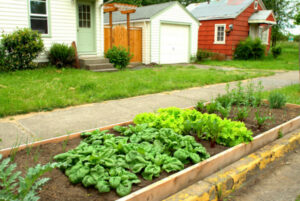Los Angeles City Sidewalks are About to Become Overgrown with Edible Gardens

Earlier this year, Los Angeles passed a small but noteworthy ordinance. You probably didn’t know you needed a permit to plant edible gardens in a parkway—the formal name for that little patch of land between the sidewalk and the street. Well, that’s not the case anymore: since the L.A. City Council passed the ruling in March, residents can now plant food in front of their houses, and for free.
While it may seem like it already belongs to the property owner whose home is just behind the parkway, the city of Los Angeles technically owns that spot (even though your landscapers probably tend to it). Pretty much anything you’d grow in a backyard garden is fair game for parkways (except for fruit trees, which do still require a permit).
If you think you’ve seen someone in LA doing this already, then you may have seen urban gardener Ron Finley’s front yard, or his viral TEDx talk. The South Central resident faced fines and arrest for years for taking over his parkway with vegetables because he “was tired of driving miles to find healthy food,” reports Fast Company. Finley said he couldn’t and wouldn’t pay the $400 permit fee to grow food on his parkway, and after his TEDx talk became a hot internet meme (“growing food is like printing your own money” he famously said), more guerilla gardening acts popped up all across the city.
“In some of these neighborhoods, that’s the only place people have to plant,” Finley told Fast Company. “Between the concrete, asphalt, and chain link fences, they don’t have any other places. To me, it’s about making food hyperlocal. Not just local, hyperlocal.”
And at a time when drought is ravaging the state, that little plot of dirt may be more valuable than meets the eye: it requires far less water than commercial farming yet can grow an abundance of healthy, delicious food. Plus, food that’s grown at home helps reduce monthly food expenses and that money can go to other foods or expenses that may be increasing in price due to the drought.
Of course, there are other benefits to growing our own food too, namely promoting healthy eating among our children. Finley says this is an issue plaguing his neighborhood and others like it across the country dubbed “food deserts.” Kids in particular don’t have access to fresh food and then grow a distaste for it, preferring processed junk food that’s contributing to the rise in childhood obesity and type 2 diabetes. Finley’s comment about having to drive miles for carrots isn’t hyperbole; supermarkets simply don’t exist in many densely populated parts of the country despite the demand.
In Los Angeles, where sunshine is an often under-utilized commodity (the city is also working on plans to bring solar roofs to some of the same neighborhoods struggling with few healthy food options), growing food is not just a move to tackle the lack of healthy food options, but it can be life-changing. “I tell people, ‘Change your food, change your life,'” Finley says. “Grow your food, save your life.” And when doing so is as free as it is easy, why not?
Find Jill on Twitter and Instagram
Related on Organic Authority
What is Urban Gardening? The Hot Trend That’s Taking Over Cities
The Next Urban Garden Trend: On Your Bike?
Step-By-Step Guide to Your Next Indoor Windowsill Winter Garden
Sidewalk garden image via Shutterstock

